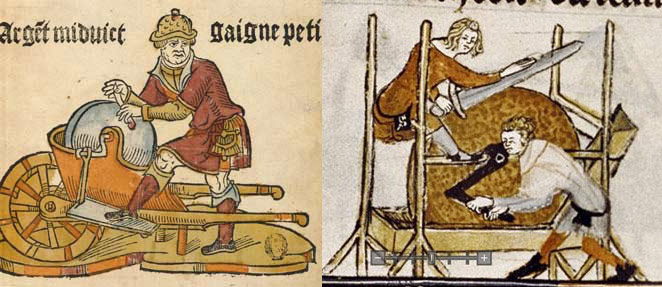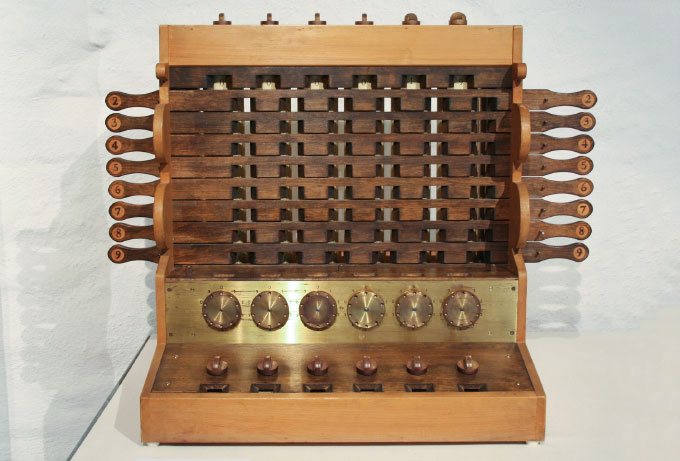What is UX / UI design really?
A lot of misunderstandings among designers and developers. There are also a lot of stupid questions related to UX and UI for beginners. Often, simply because people do not know the essence of the concept UX / UI and, not knowing what they are talking about, they do not call things by their proper names.
I want to put an end once and for all and to explain in simple plain language what it means to “UX / UI design”.

Different types of sharpening interfaces.
')
Do you press the buttons on the adding machine, twist the knob of the grindstone, or make a swipe across the screen of the smartphone - these are all interfaces through which you interact with the mechanisms. In this case, the interface does not have to be digital. Just the word "interface" was borrowed from English quite recently and has come down to us in only the digital age.
The goal of the UI / UX designer is to bring the user to some logical point in the interface. Make it so that the user reaches his goal.
UX is a User Experience (literally: "user experience"). That is, this is what experience / impression the user gets from working with your interface. Is he able to achieve the goal and how simple or difficult to do it?
And the UI is the User Interface (literally “user interface”) - what the interface looks like and what physical characteristics it acquires. It determines what color your “product” will be, whether it will be convenient for a person to hit the buttons with a finger, whether the text will be readable, and so on ...
UX / UI design is the design of any user interfaces in which usability is as important as the appearance.
The direct responsibility of the UX / UI designer is, for example, to “sell” a product or service through the interface. It is on the basis of the work of the UX / UI designer that the user decides: “To be or not to be?” Like or Dislike. Buy or not buy.
UX / UI design does not apply only to smartphones and web sites. Moreover, the profession of UX / UI designer has existed since time immemorial. Just before she was not called. More precisely, earlier it was not called at all, but was part of other professions.
Here is the first example: when Wilhelm Schickard invented the adding machine in 1623, he was already a UX / UI designer.

Because he was the one who thought out which toggle switches and in what sequence a person has to turn in order to get the result of the calculations. And he invented the logical order in which they would be located. And generally thought out how all these pens will look. He created an interface for interacting with the machine.
Another more ancient and primitive example is a whetstone (wheel). Already even in the early Middle Ages there were many varieties and mechanisms of such a wheel:
All these were different types of interfaces.

So, when the inventor of the next grinding stone thought:
then at that moment he was a UX designer .
And the person who thought what size a stone would be, what color to choose a tree for a stand and how to fasten wooden poles (nails or leather plaits?) And how long the handle would be, was the UI designer .
And the way you would sharpen your sword would be the interface .
The difference between UX and UI is that the UX designer plans how you will interact with the interface and what steps you need to take to do something. And the UI designer comes up with how each of these steps will look. As you can see from the examples above, UX and UI are so closely related that sometimes the line between concepts is washed away. Therefore, both UX and UI are usually taken by one designer and his profession is written in /.
UI / UX design is now one of the most sought-after professions in the digital industry. How long it will be claimed depends on the development of this industry. And, apparently, it is only gaining momentum.
UX and UI are not trends. Technologists are developing. Demand for sites is growing. Digital applications appear like mushrooms. And the design and development tools are simplified to such an extent that almost anyone without knowledge of programming can do a business card on their knees. That's just this site should look like. And not just as an abstract frame of text and buttons. Here programmers need the help of UX / UI designer.
PS Some people write UI / UX, but I prefer to write UX / UI. And this is only because in the workflow, UX is done first, and then UI. But it does not matter - write whatever you want. The main thing is not to confuse this order during the work process itself. Because many novice designers are beginning to first come up with what cool buttons and chips will be in their interface. But they do not think about how the user will move from one step to another.
I want to put an end once and for all and to explain in simple plain language what it means to “UX / UI design”.

Different types of sharpening interfaces.
')
Do you press the buttons on the adding machine, twist the knob of the grindstone, or make a swipe across the screen of the smartphone - these are all interfaces through which you interact with the mechanisms. In this case, the interface does not have to be digital. Just the word "interface" was borrowed from English quite recently and has come down to us in only the digital age.
The goal of the UI / UX designer is to bring the user to some logical point in the interface. Make it so that the user reaches his goal.
What is UX / UI, direct text
(this section will be banal phrases)UX is a User Experience (literally: "user experience"). That is, this is what experience / impression the user gets from working with your interface. Is he able to achieve the goal and how simple or difficult to do it?
And the UI is the User Interface (literally “user interface”) - what the interface looks like and what physical characteristics it acquires. It determines what color your “product” will be, whether it will be convenient for a person to hit the buttons with a finger, whether the text will be readable, and so on ...
UX / UI design is the design of any user interfaces in which usability is as important as the appearance.
What is UX and UI design, in other words
The direct responsibility of the UX / UI designer is, for example, to “sell” a product or service through the interface. It is on the basis of the work of the UX / UI designer that the user decides: “To be or not to be?” Like or Dislike. Buy or not buy.
In fact, the goals of the designer may be different. Not necessarily something to "sell." But I specifically do not want to use too abstract phrases for this text to be understandable for beginners; so that the style of presentation is not turned into a reader on the programming language of the sample of the 90s.
UX / UI design does not apply only to smartphones and web sites. Moreover, the profession of UX / UI designer has existed since time immemorial. Just before she was not called. More precisely, earlier it was not called at all, but was part of other professions.
Here is the first example: when Wilhelm Schickard invented the adding machine in 1623, he was already a UX / UI designer.

Because he was the one who thought out which toggle switches and in what sequence a person has to turn in order to get the result of the calculations. And he invented the logical order in which they would be located. And generally thought out how all these pens will look. He created an interface for interacting with the machine.
Another more ancient and primitive example is a whetstone (wheel). Already even in the early Middle Ages there were many varieties and mechanisms of such a wheel:
- it could be rotated by hand
- the other person could turn the wheel
- or it could be spun even without hands, pressing the pedal with your foot
- other...
All these were different types of interfaces.

So, when the inventor of the next grinding stone thought:
- will he sit and push the pedal himself
- or he will simplify the mechanism, but put a slave who will unwind the wheel with his hand,
then at that moment he was a UX designer .
And the person who thought what size a stone would be, what color to choose a tree for a stand and how to fasten wooden poles (nails or leather plaits?) And how long the handle would be, was the UI designer .
And the way you would sharpen your sword would be the interface .
The difference between UX and UI is that the UX designer plans how you will interact with the interface and what steps you need to take to do something. And the UI designer comes up with how each of these steps will look. As you can see from the examples above, UX and UI are so closely related that sometimes the line between concepts is washed away. Therefore, both UX and UI are usually taken by one designer and his profession is written in /.
Recently, the popularization of the profession UX / UI designer is associated more with the development of digital technology. But exactly that “boom” (when we began to see the term “UX / UI” in every second job ad) is associated with the name itself, which someone coined recently.
UI / UX design is now one of the most sought-after professions in the digital industry. How long it will be claimed depends on the development of this industry. And, apparently, it is only gaining momentum.
UX and UI are not trends. Technologists are developing. Demand for sites is growing. Digital applications appear like mushrooms. And the design and development tools are simplified to such an extent that almost anyone without knowledge of programming can do a business card on their knees. That's just this site should look like. And not just as an abstract frame of text and buttons. Here programmers need the help of UX / UI designer.
The division into web designers and UX / UI designers has emerged with the development of the Internet. Over time, narrower specialists were needed that would make interfaces specifically for websites.
Yes, UI / UX design is a broader and more comprehensive concept than web design.
PS Some people write UI / UX, but I prefer to write UX / UI. And this is only because in the workflow, UX is done first, and then UI. But it does not matter - write whatever you want. The main thing is not to confuse this order during the work process itself. Because many novice designers are beginning to first come up with what cool buttons and chips will be in their interface. But they do not think about how the user will move from one step to another.
Source: https://habr.com/ru/post/321312/
All Articles